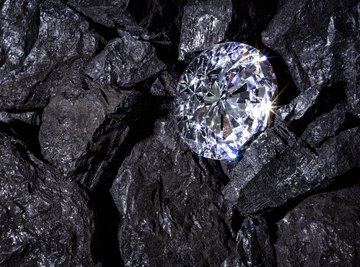
Organic compounds are those upon which life depends, and they all contain carbon. In fact, the definition of an organic compound is one that contains carbon. It's the sixth most abundant element in the universe, and carbon also occupies the sixth position on the periodic table. It has two electrons in its inner shell and four in the outer one, and it's this arrangement that makes carbon such a versatile element. Because it can combine in so many different ways, and because the bonds carbon forms are strong enough to remain intact in water – the other requirement for life – carbon is indispensable for life as we know it. In fact, an argument can be made that carbon is necessary for life to exist elsewhere in the universe as well as on Earth.
TL;DR (Too Long; Didn't Read)
Because it has four electrons in its second orbital, which can accommodate eight, carbon can combine in many different ways, and it can form very large molecules. Carbon bonds are strong and can stay together in water. Carbon is such a versatile element that almost 10 million different carbon compounds exist.
It's About Valency
The formation of chemical compounds generally follows the octet rule by which atoms seek stability by gaining or losing electrons to achieve the optimum number of eight electrons in their outer shell. To this end, they form ionic and covalent bonds. When forming a covalent bond, an atom shares electrons with at least one other atom, allowing both atoms to achieve a more stable state.
With only four electrons in its outer shell, carbon is equally capable of donating and accepting electrons, and it can form four covalent bonds at once. The methane molecule (CH4) is a simple example. Carbon can also form bonds with itself, and the bonds are strong. Diamond and graphite are both composed entirely of carbon. The fun starts when carbon bonds with combinations of carbon atoms and those of other elements, particularly hydrogen and oxygen.
The Formation of Macromolecules
Consider what happens when two carbon atoms form a covalent bond with each other. They can combine in several ways, and in one, they share a single electron pair, leaving three bonding positions open. The pair of atoms now has six open bonding positions, and if one or more is occupied by a carbon atom, the number of bonding positions quickly grows. Molecules consisting of large strings of atoms of carbon and other elements are the result. These strings can grow linearly, or they can close in and form rings or hexagonal structures that can also combine with other structures to form even larger molecules. The possibilities are almost limitless. To date, chemists have catalogued almost 10 million different carbon compounds. The most important for life include carbohydrates, which are formed entirely with carbon, hydrogen, lipids, proteins and nucleic acids, of which the best-known example is DNA.
Why Not Silicon?
Silicon is the element just under carbon in the periodic table, and it's about 135 times more abundant on Earth. Like carbon, it has only four electrons in its outer shell, so why aren't the macromolecules that form living organisms silicon-based? The main reason is that carbon forms stronger bonds than silicon at temperatures conducive to life, especially with itself. The four non-paired electrons in silicon's outer shell are in its third orbital, which can potentially accommodate 18 electrons. Carbon's four unpaired electrons, on the other hand, are in its second orbital, which can accommodate only 8, and when the orbital is filled, the molecular combination becomes very stable.
Because the carbon-carbon bond is stronger than the silicon-silicon bond, carbon compounds stay together in water while silicon compounds break apart. Besides this, another probable reason for the dominance of carbon-based molecules on Earth is the abundance of oxygen. Oxidation fuels most life processes, and a by-product is carbon dioxide, which is a gas. Organisms formed with silicon-based molecules would probably also get energy from oxidation, but since silicon dioxide is a solid, they would have to exhale solid matter.
References
About the Author
Chris Deziel holds a Bachelor's degree in physics and a Master's degree in Humanities, He has taught science, math and English at the university level, both in his native Canada and in Japan. He began writing online in 2010, offering information in scientific, cultural and practical topics. His writing covers science, math and home improvement and design, as well as religion and the oriental healing arts.
